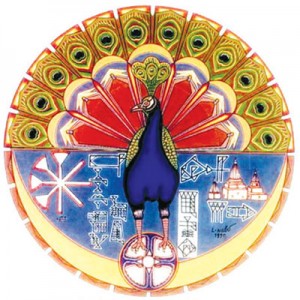Appealing to the ‘Peacock Angel’
Washington DC, October 29: A delegation of top Yezidi spiritual and political leaders visited Washington DC recently (October 24-31) seeking support for their minority community in Iraq, which is under relentless assault by ISIS religious extremists, who consider the ancient religious minority to be pagans.
In a visit deep in symbolic and historical significance, the Baba Sheikh, spiritual leader of the Yezidis, also visited the Murugan Temple of North America on October 29 to observe the conclusion of Skanda Sashti, the ritual observance of the deity’s six-day war against demonic forces threatening the earth. It was the first time ever that the Yezidi spiritual leadership has visited a temple of god Skanda-Murugan, whom Yezidis identify with Ta’us Melek, the ‘Peacock Angel’.
In the secretive Yezidi religion, Ta’us Melekis considered to be the leader of the archangels and an emanation of God himself. Yezidi religion is centred upon the Peacock Angel, to whom Yezidis pray five times daily.
Ta’us Melek is depicted in the form of a peacock. However, peacocks are not native to the lands where Ta’us Melek is worshipped, but to the Indian subcontinent. Yezidis, moreover, still preserve a caste system and belief in reincarnation, two core tenets of Hinduism. Indeed, Yezidi oral tradition maintains that they once lived in India thousands of years ago, before they returned to their original homeland in northern Iraq.
According to the Yezidi calendar, April 2014 marked the beginning of their year 6,764; thereby year 1 would have been in 4,750 BC in the Gregorian calendar. Scholars of religion concede that the Yezidi faith has absorbed and preserved many elements from ancient faiths including Mithraism, Zoroastrianism, and Sufism or mystical Islam—all targets of hardline ISIS fundamentalist doctrine.
“The Yezidis are a very special religious community because they’re one of the only remaining religions in the Middle East with non-Abrahamic origins,” says Matthew Barber, a scholar at the University of Chicago’s Department of Near Eastern Languages and Civilisations.
“The Yezidi religion has absorbed elements from many religious traditions in the Near East, but within their religious framework are preserved some very ancient beliefs that no longer survive in any other religion. The reason that ISIS attacks the Yezidi community in this way is because they view them as pagan and polytheistic because they’re outside of the Abrahamic religions that have a written scripture.”

Yezidi leader Baba Sheikh at the Murugan Temple
The Baba Sheikh and entourage evinced a keen interest in the god Murugan’s associations with the peacock. They were astonished to see tall brass oil lamps crowned with peacocks, bearing an uncanny resemblance to Yezidis’ own brass peacock lamps that play a central role in their own living traditions.
The god Skanda was among North India’s most popular deities during its classical age in the first millennium of the Common Era. He remains extremely popular in South India, Sri Lanka, Malaysia and worldwide especially among the Tamil diaspora who know Him as Murugan, the tender youth associated with Tamil poetry, love, and war.
The Baba Sheikh blessed devotees who had assembled on Skanda Sashti and urged them to work towards world peace and not to descend into bigotry and intolerance, which are the hallmarks of religious fundamentalism. Local devotees and Yezidi visitors alike marvelled at the profound convergence of two ancient faiths on Skanda Sashti, and all prayed that their Lord of the Peacock would soon answer the fervent prayers of Yezidis in Iraq and worldwide.
Patrick Harrigan is an American indologist specialising since 1972 in the Sri Lankan shrine Kataragama regarded as sacred by the island’s Buddhist, Hindu, Muslim, and Veddah communities. A co-founder of the Kataragama Devotees Trust, he has walked the Kataragama Pada Yatra twenty times since 1972.


